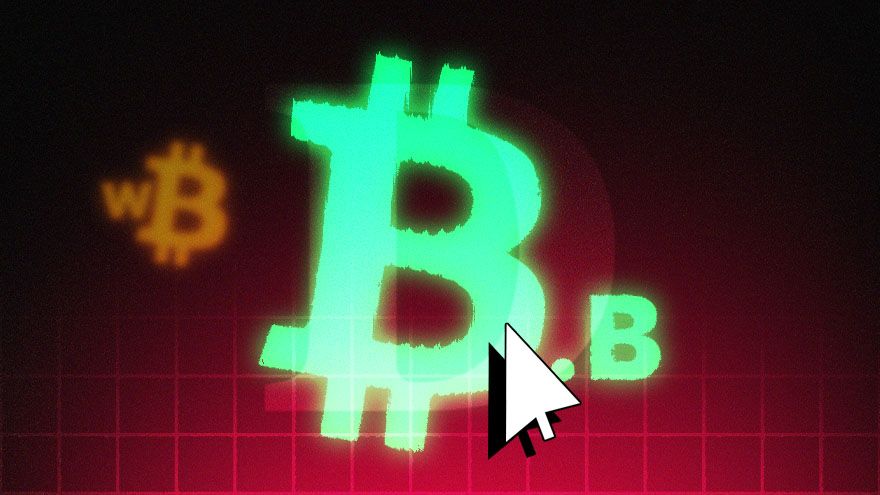Signs are emerging that the biggest Bitcoin-like token can be unseated. BTC.b is outpacing the long-standing incumbent, Wrapped Bitcoin, on the Avalanche network.
On Sunday, Trader Joe, the top decentralized exchange on Avalanche, tweeted it had processed nearly $1B worth of BTC.b trades across its Avalanche, Arbitrum, and BNB deployments.
According to DexTools, BTC.b volume beat out WBTC on Avalanche by 12% over the past 24 hours.
Bitcoin holders who want to use their BTC on other blockchains, for example, to gain interest or use as loan collateral, can issue tokens that represent their BTC holdings on those chains. The biggest of these BTC derivatives is WBTC, with a market capitalization of $4.4B. WBTC relies on centralized third parties to custody Bitcoin, and a limited set of institutions can issue the token to then sell to individuals.
BTC.b, the wrapped Bitcoin upstart, can be issued by bridging Bitcoin to Avalanche using the Core extension, and bridged to other blockchains using LayerZero.
“For a long time, the primary way to use Bitcoin in DeFi was by relying on centralized bridges such as WBTC,” Trader Joe said.
The growing popularity of BTC.b highlights the appetite for decentralized and trustless alternatives to the centralized bridges that underpin much of cross-chain DeFi. Centralized bridges proved to offer enticing honey pots for hackers in recent years, accounting for $2B or two-thirds of the total losses to crypto exploits last year, according to Chainalysis.
Fast Rise
LayerZero quickly rose to prominence as a leading team working on cross-chain interoperability over the past year, having processed more than $6B worth of bridging transactions since launching in March 2022. However, two-thirds of its cumulative volume was processed during the six weeks following Aribtrum’s $1.7B airdrop on March 23.
However, LayerZero’s purported trustlessness came under scrutiny in January, when a researcher flagged that the protocol’s design could facilitate malicious collusion between the project’s Oracles and Relayers.
“[The paper’s authors] directly state that in order for their mechanics to work, it’s required that Oracle and Relayer are independent and do not collude,” Krzysztof Urbański of L2Beat, a crypto analytics website, told The Defiant. “But it’s up to app developers to choose who is serving as Oracle and Relayer, so they are free to set it up in a way that they are actually dependent and that they do collude.”
LayerZero responded that Urbański’s research rehashed information that was already in the public domain.
“You can build good and bad things on top of it, just like you can build good and bad things on the internet and blockchains.” Ryan Zarick, LayerZero Labs’ co-founder, said.
Trader Joe emphasized the composability of LayerZero’s Omnichain Fungible Tokens (OFT) standard, which underpins BTC.b.
“OFT means that users don’t have to worry about constant wrapping/unwrapping, and DeFi projects can easily integrate BTC.b into their applications,” it said.
More than 5,700 Bitcoin have been bridged onto Avalanche via BTC.b, equating to a $163.8M market cap, according to CoinGecko. Users have bridged more than 2,500 BTC.b via LayerZero, indicating the token enjoys significant adoption across multiple chains, including Arbitrum and BNB Chain.
Read More: thedefiant.io









 Bitcoin
Bitcoin  Ethereum
Ethereum  Tether
Tether  XRP
XRP  Solana
Solana  USDC
USDC  Dogecoin
Dogecoin  Cardano
Cardano  TRON
TRON  Lido Staked Ether
Lido Staked Ether  Wrapped Bitcoin
Wrapped Bitcoin  LEO Token
LEO Token  Chainlink
Chainlink  Toncoin
Toncoin  USDS
USDS  Wrapped stETH
Wrapped stETH  Stellar
Stellar  Avalanche
Avalanche  Shiba Inu
Shiba Inu  Sui
Sui  Hedera
Hedera  Litecoin
Litecoin  MANTRA
MANTRA  Polkadot
Polkadot  Bitcoin Cash
Bitcoin Cash  Bitget Token
Bitget Token  Ethena USDe
Ethena USDe  Binance Bridged USDT (BNB Smart Chain)
Binance Bridged USDT (BNB Smart Chain)  WETH
WETH  Pi Network
Pi Network  Wrapped eETH
Wrapped eETH  WhiteBIT Coin
WhiteBIT Coin  Monero
Monero  Hyperliquid
Hyperliquid  Uniswap
Uniswap  OKB
OKB  Dai
Dai  sUSDS
sUSDS  Pepe
Pepe  NEAR Protocol
NEAR Protocol  Aptos
Aptos  Gate
Gate  Coinbase Wrapped BTC
Coinbase Wrapped BTC  Tokenize Xchange
Tokenize Xchange  Ondo
Ondo  Cronos
Cronos  Mantle
Mantle  Internet Computer
Internet Computer  Ethereum Classic
Ethereum Classic